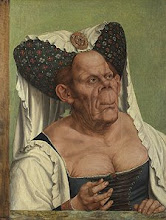Above is Hans Baldung Grien's version of Death and Beauty, and it really isn't that pretty. Like I wrote previously, religion played a large role during the Renaissance, so on the few occasions that secular imagery was painted, it generaly had to do with daily fears and frustrations of the public. Grien has painted four stages of life on the panel, with the last stage of Death holding an hour glass above all the other's heads. Clock is ticking!
So why has there been such a long fear of death and decay? Did the fear exist before the time of Christianity?
